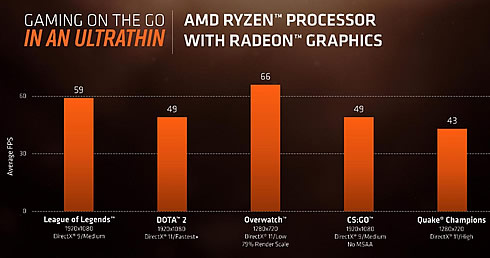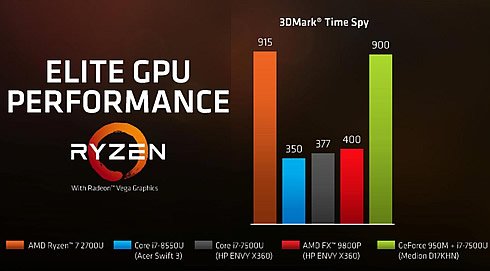
Zen Cores Meet With Vega GPU cores in New AMD Ryzen Mobile Processors
AMD announced today its first two processors to combine its new Zen CPU architecture with its Vega graphics cores. The new chips, previously codenamed the "Raven Ridge", have been designed for lightweight mobile systems and compete with Intel's U-series processors.
With a configurable 15-watt TDP, the AMD Ryzen 7 2700U and AMD Ryzen 5 2500U processors combine the architecture of "Zen" x86 cores--featuring AMD SenseMI Technology processor-level intelligence--with Radeon "Vega" graphics in a System-on-Chip design.
Both new chips include a single Zen CCX, a module containing four cores and eight threads, along with 4MB of level 3 cache. They integrate this with either 10 Vega compute units (CUs) for the 2700U or eight CUs for the 2500U. The 2700U has a base clock speed of 2.2GHz, boosting up to 3.8, and a GPU clock speed of up to 1.3GHz. The 2500U shaves off 200MHz from all of these speeds.

Like Intel's U-series chips, these chips have a nominal 15W power draw, and system builders can configure this, going as high as 25W for systems with strong cooling or as low as 12W.
AMD is using a few benchmarks to showcase the performance of its new chips. In the rendering Cinebench benchmark's single-threaded test, the Kaby Lake-R chip is about 10 percent faster. Under single threaded workloads, the slightly higher maximum turbo frequency and IPC advantage wins out. But in the multithreaded test, the AMD chip has a whopping 44-percent lead. Ryzen already showed that AMD's simultaneous multithreading implementation showed advantages. That, combined with a higher clock speed, allows the Ryzen to beat the Kaby Lake-R.
Similar results are found in POVRay, PCMark 10, and TrueCrypt.
On the graphics side, AMD is using the Time Spy subtest of 3DMark. Here the company is claiming performance of more than double that of Kaby Lake-R, even edging slightly ahead of a previous generation Kaby Lake paired with a GeForce 950M discrete GPU. AMD is also claiming respectable framerates across a range of games, albeit at reduced quality settings.

AMD's desktop Ryzen chips use the company's Precision Boost feature: the processor performance is adjusted in real time to meet the performance demands, with Precision Boost to adjust clockspeeds in 25MHz increments.

The mobile parts introduce Precision Boost 2. The mobile chips can increase the clock speed of any number of CPU cores, as long as there is power and thermal freedom to do so.

That same clock speed control, with the power and thermal constraints, also applies to the GPU, with the chip's power management system trading off power between the individual CPU cores and the GPU core depending on load and headroom. When the processor knows it's running cool and quiet, it can raise clock speeds in precise 25MHz steps for any application.
The processors also employ an artificial neural network to understand your applications and anticipate the next steps of your workflow in real time. These "powers of prediction" can boost performance by steering your apps and games down the most efficient paths inside the processor.
The processors also use power gating to enable parts to be turned off when not in use. Some 95 percent of the GPU can be powered down, as can all of the cores. In this state, power to the processor is substantially turned off. At a static Windows desktop, AMD says that the chips can be in this powered-down state 99 percent of the time. The multimedia hub can also be powered separately from the CPU and main GPU core.

The multimedia engines of the new chips now support 10-bit H.265/HEVC decoding for 4K video and VP9.
When AMD announced it was creating the new high-performance Zen core, they set a lofty goal. They wanted to produce products that offered 25x the relative efficiency (performance per watt) between 2014 and 2020. This was called the 25x20 goal, and AMD gave an update. The company claims that it is ahead of pace for its 25X20 initiative, with the AMD Ryzen 7 2700U processor enabling a 5.86X energy efficiency improvement since the beginning of the initiative.
HP ENVY x360 15 powered by Ryzen Mobile
In the coming weeks, initial systems powered by Ryzen mobile processors are slated to be available from manufacturers including Acer, HP and Lenovo, with further platform updates expected from Dell, Asus and other OEMs in early 2018.

As part of the launch for the new Ryzen Mobile platform from AMD, HP is today announcing a refresh of their HP ENVY x360 15-inch laptop which features the AMD Ryzen 5 2500U processor.
HP is offering the Ryzen 5 2500U option, which is four cores, eight threads, and a 2.0 GHz base frequency with 3.6 GHz boost frequency. As with Intel's CPUs, it has a 15-Watt nominal TDP. HP has paired it with up to 8 GB of DDR4 RAM in dual-channel mode.
The Ryzen 5 2500U has eight Radeon RX Vega CUs, with a boost frequency of up to 1100 MHz.
The rest of the laptop is similar to the existing HP ENVY x360 15-inch model. It offers up to a 512 GB SSD, or 1 TB SATA HDD, and features Intel 802.11ac wireless. The display is a 15.6-inch IPS 1920x1080 panel, featuring thin side bezels and edge-to-edge glass. The laptop features an IR webcam for Windows Hello support, and offers a full-size backlit keyboard with a number pad as well. The laptop weighs in at 4.75 lbs.
For connectivity and more, the HP ENVY x360 offers USB-C with DisplayPort and power capabilities, and HP lists the laptop as able to drive two UHD displays.
The Ryzen Mobile powered HP ENVY x360 starts at $699, with availability in November.





















